Eclipse mania gripped North America Monday as a breathtaking celestial spectacle set to be witnessed by tens of millions of people offered a rare convergence of commercial and scientific opportunities – and an excuse to party.
The first total solar eclipse to grace North America in seven years made landfall in Mexico Monday for the start of a celestial display at least partially visible, weather permitting, across most of the continent.
The Mexican beachside resort town of Mazatlan was the first major viewing spot along the "path of totality" in North America.
Thousands of people gathered along the coastal promenade, setting themselves up in deck chairs with solar-safe eyewear as an orchestra played the *Star Wars movie theme.
The crowds burst into cheers and applause and the eclipse reached totality.
Where clear skies prevail, observers along the direct path of the eclipse were being treated to the rare spectacle of the moon appearing as a dark orb creeping in front of the sun, briefly blocking out all but a brilliant halo of light, or corona, around, the sun's outer edge.
The period of totality, lasting up to 4.5 minutes depending the observer's location, was ushered in by a number of other eerie eclipse effects.
A partial eclipse, in which the moon obscures only a portion of the sun, was unfolding across most of the continental United States.
The moon's shadow plunged the Pacific coast of Mexico into total darkness at 11.07am local time (1807 GMT) and was sweeping across the United States, before returning to the ocean over Canada's Atlantic coast just under an hour-and-a-half after landfall.
Festivals, viewing parties, and even mass weddings were planned along the eclipse's "path of totality", where the moon could be seen completely obscuring the sun for up to a few minutes – weather permitting.
Cloud cover was forecast over Texas and northeastern US states.
Mexican President Andres Manuel Lopez Obrador visited Sinaloa to witness firsthand eclipse from the resort of Mazatlan, describing the event as a "very beautiful, unforgettable day”.
Thousands gathered in Mexico City, just outside the path of totality.
"These are opportunities given by Earth and nature that we must seize," 29-year-old artist Mariana Juarez told AFP.
This year's path of totality is 115 miles (185km) wide and home to nearly 32mn Americans, with an additional 150mn living less than 200 miles from the strip.
The next total solar eclipse that can be seen from a large part of North America won't come around until 2044.
At Mazatlan, Lourdes Corro, 43, traveled 10 hours by car to get there.
"The last one I saw was when I was 9," Corro said. "There are a few clouds but we can still see the sun."
In upstate New York, at the Frontier Town campground in North Hudson, children ran around wearing eclipse T-shirts, while parents set up tables, chairs and coolers.
Connecticut residents Bob and Teresa Love were stretched out in the cargo bed of their pickup truck, eating pastries and hoping the forecasted clouds hold off long enough to not obscure the spectacle.
"I'm trying not to get too excited because of weather, just trying to keep expectations real," said Teresa, 49. "Some people say it's life-changing. I don't know if it's going to be life-changing, but I think it's going to be cool to see."
At up to four minutes and 28 seconds, the total eclipse of 2024 surpasses the duration of the one that traversed the United States from coast to coast in 2017.
That one clocked in at up to two minutes and 42 seconds.
According to the National Aeronautics and Space Administration (Nasa), total eclipses can last anywhere from 10 seconds to about 7.5 minutes.
Some other cities along the path of totality include: San Antonio, Austin and Dallas, Texas; Indianapolis, Indiana; Cleveland, Ohio; Erie, Pennsylvania; both Niagara Falls, New York, and Niagara Falls, Ontario, site of the famed waterfall, and Montreal, Quebec.
About 32mn people in the United States live within the path of totality, with federal officials predicting another 5mn people will travel to be there.
Countless eclipse-watching events were being convened at stadiums, fairgrounds and parks along the path of totality.
Businesses capitalised on the excitement with special events, while hotels and short-term rentals in prime viewing locations were booked solid for months in advance.
Delta airlines has planned two special flights along the path, while many schools in the zone shut for the day.
Research firm Perryman Group estimates direct and indirect economic impacts of this year's eclipse could reach $6bn.
Small rural towns bustled, such as Advance, Missouri, home to just over 1,300 people, where Tim and Gwen Wurst had driven from their Kansas City home after checking weather forecasts.
They had been thrilled to witness a partial eclipse in 2017 and were excited for totality.
"It's been on the calendar for years," said Tim Wurst, 62. "It was very dusky and dim the last eclipse, but this one should be just all-out dark."
Experts urge the use of protective solar glasses to prevent eye damage that would otherwise occur from starting directly at the sun.
Only during the few minutes of totality can the sun can be safely viewed without such eyewear, they said.
Overcast skies are among an eclipse-chaser's worst fears.
The US National Weather Services forecast as of morning Monday was for "a rapid untimely increase of clouds" in Southern Texas; less worrying "high thin clouds" for a swathe from Arkansas to the Midwest; and the clearest skies in northern New England.
It will take about 80 minutes from the moment the moon first begins to cover the sun to the moment of totality, then another 80 minutes to complete the process in reverse.
Eclipse veterans have described the 15 minutes before totality as foreboding, with shadows becoming oddly crisp and sunshine assuming an eerie quality.
In the seconds before totality, a phenomenon called "shadow bands" may appear – shimmering shadows on the ground, like those seen on the bottom of a swimming pool.
Some stars will also appear in midday sky as dusk abruptly descends, sending temperatures dipping. Birds and other wildlife, reacting to the sudden darkness, often fall silent and still.
The last remaining bit of brilliant sunlight before totality creates a "diamond ring effect" in which a single bright spot appears along the lunar edge even as the sun's corona leaves a ring of light around the moon.
Former president Donald Trump, who notoriously gazed directly at the sun during the 2017 eclipse, attempted to capitalise on the phenomenon by releasing a new campaign ad featuring his larger-than-life head blocking out our star.
Health professionals have stressed however not to follow his example, urging people to use certified eclipse glasses to prevent potentially permanent retinal injury.
President Joe Biden made fun of Trump with a social media post saying: "Don't be silly, folks."
International / US/Latin America
Eclipse mania grips North America
North America goes dark during the first total solar eclipse in the continent in seven years
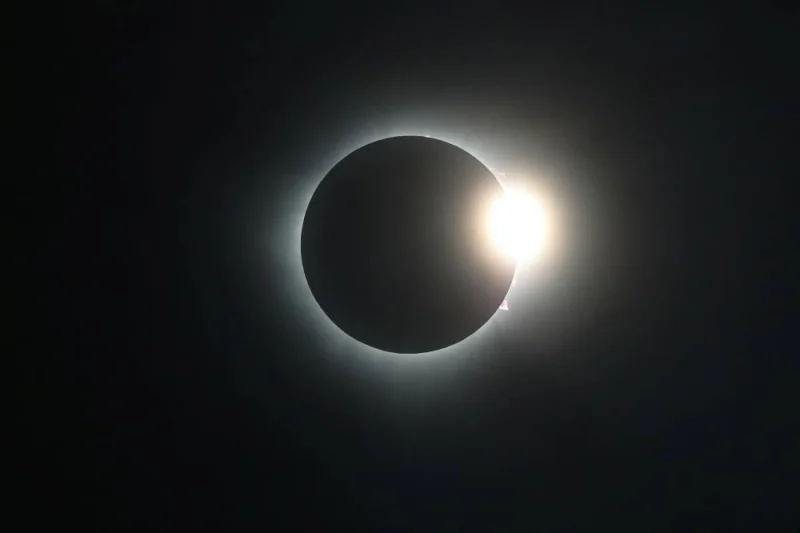
The diamond ring effect seen during the total solar eclipse is seen from Mazatlan, Mexico, Monday. REUTERS
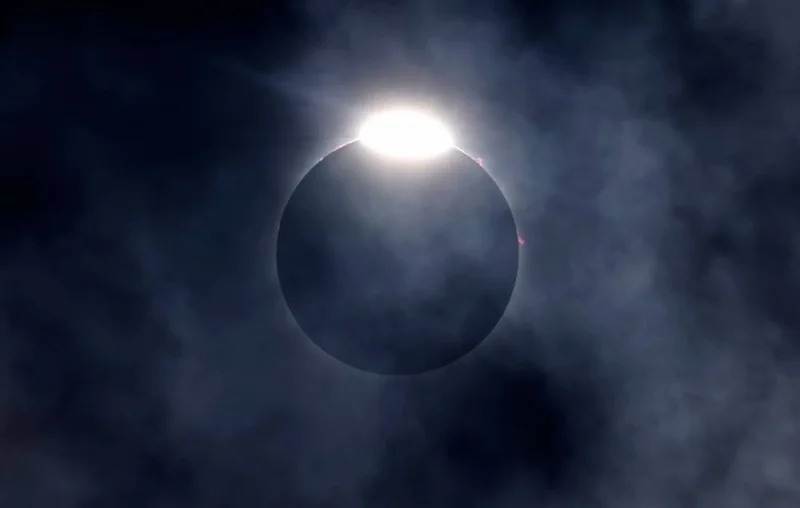
The diamond ring effect as well as Bailey's Beads are seen as the moon eclipses the sun on Monday in Fort Worth, Texas. AFP

A total solar eclipse is seen from Eagle Pass, Texas, US, Monday. REUTERS

People gather on the observation deck of Edge at Hudson Yards before a partial solar eclipse in New York City, Monday. REUTERS
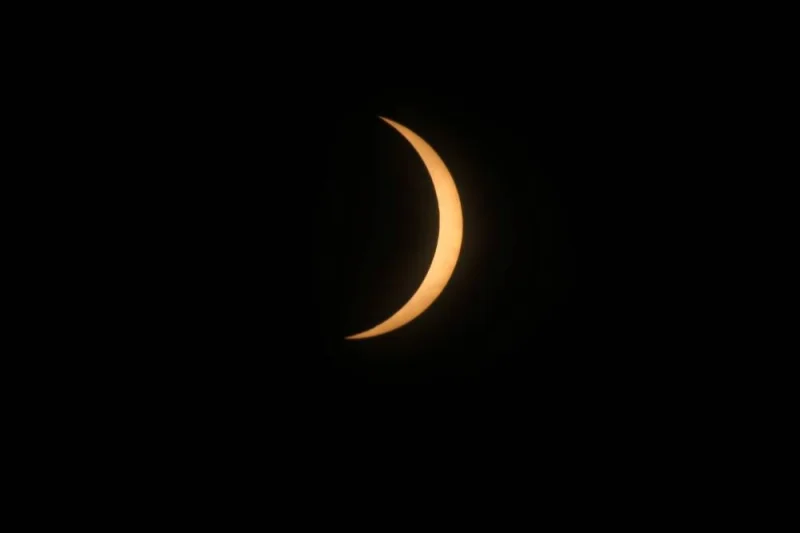
A partial solar eclipse is seen from Mazatlan, Mexico, Monday. REUTERS
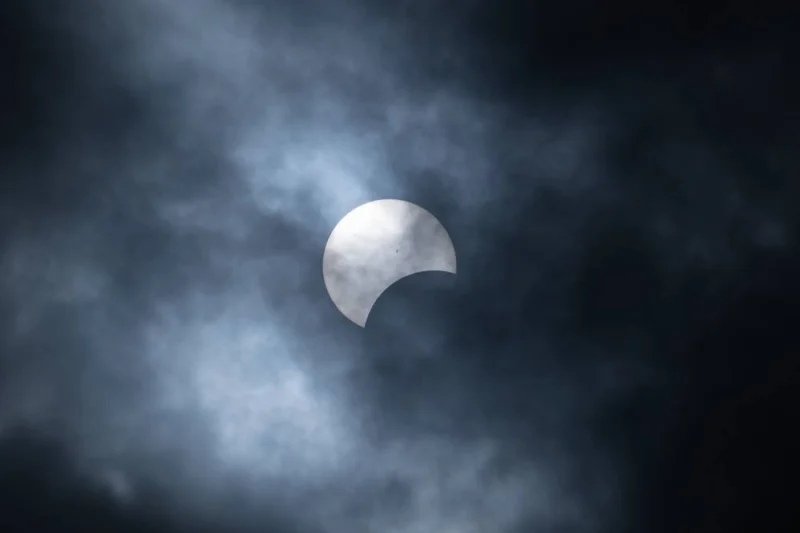
The partial Solar Eclipse is seen through clouds on Monday in Niagara Falls, New York. AFP
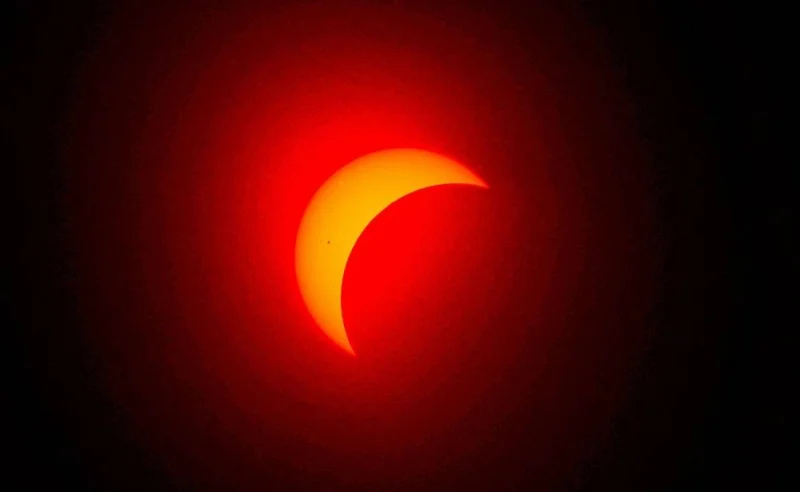
The moon eclipses the sun on Monday in Fort Worth, Texas. AFP
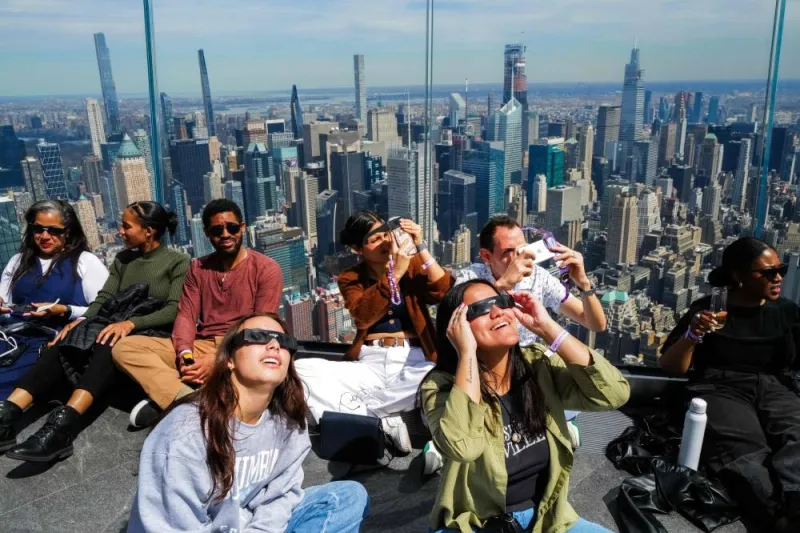
People look toward the sky at the 'Edge at Hudson Yards' observation deck ahead of a total solar eclipse across North America, in New York City on Monday. AFP
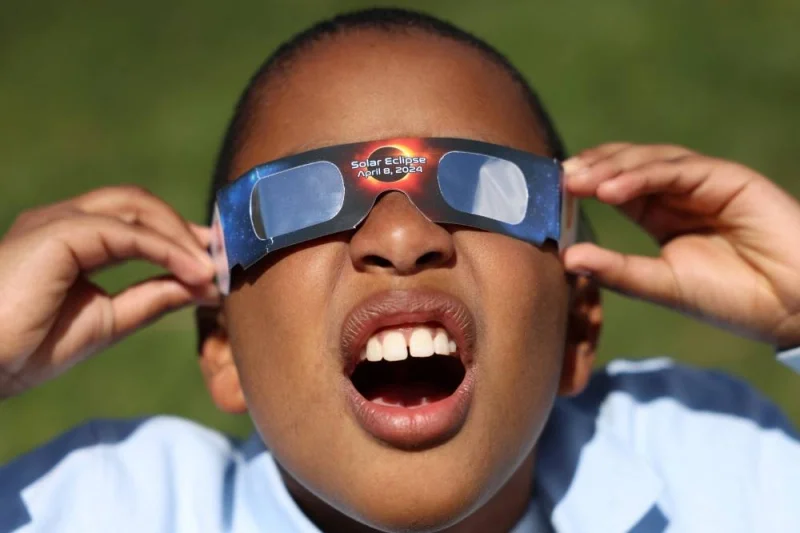
Adrian Plaza, 9, of Queens, tests his eclipse glasses ahead of a partial solar eclipse, where the moon will partially blot out the sun, at New York Hall of Science in Queens borough, New York City, Monday. REUTERS
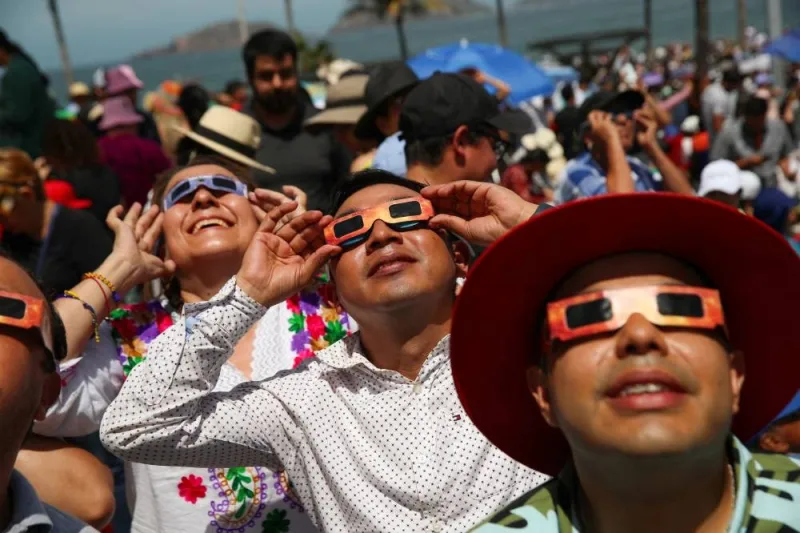
People use special protective glasses to observe a total solar eclipse in Mazatlan, Mexico, Monday. REUTERS
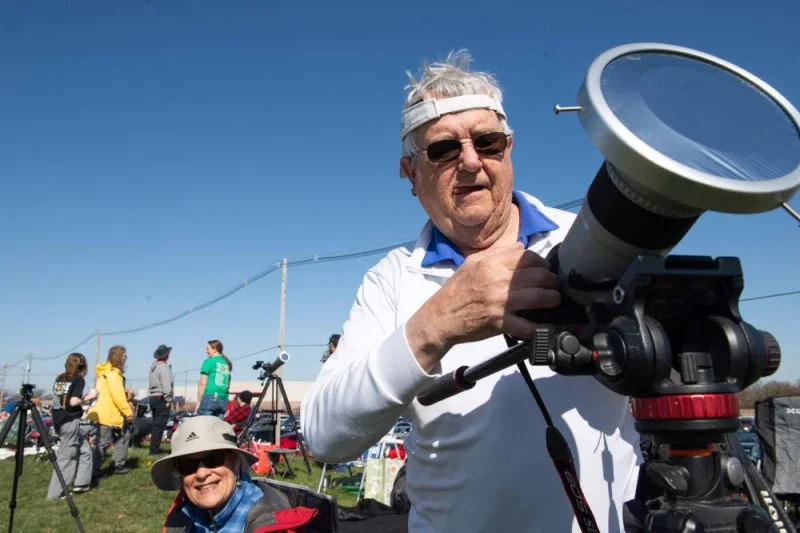
A person prepares his camera to view the total solar eclipse on Monday at the Neil Armstrong Air and Space Museum in Wapakoneta, Ohio. AFP

Some of the 309 people gathered to break the Guinness World Record for the largest group of people dressed as the sun pose while boarding a sightseeing boat, before the total solar eclipse in Niagara Falls, Ontario, Canada, Monday. REUTERS
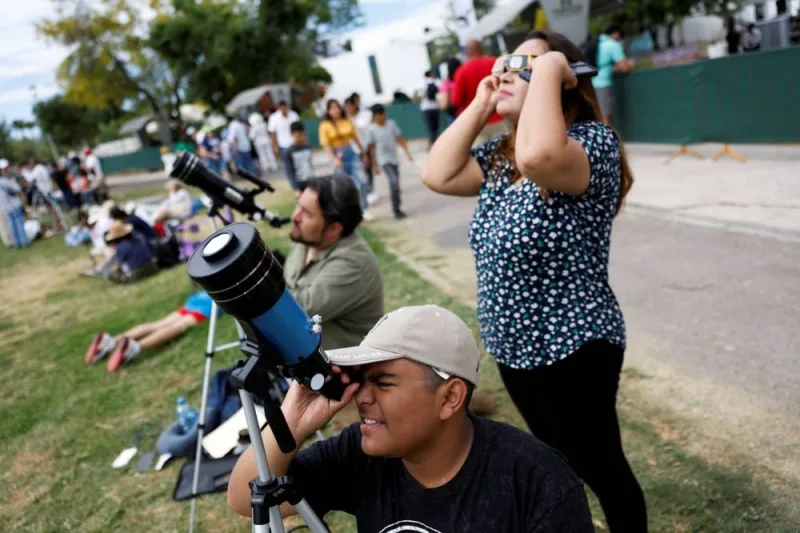
People gather as they prepare to observe the solar eclipse, in Torreon, state of Coahuila, Mexico, Monday. REUTERS

People pose for a portrait before boarding a solar eclipse flight to Detroit from Austin, Texas, Monday. REUTERS

Some of the 309 people gathered to break the Guinness World Record for the largest group of people dressed as the sun pose on a sightseeing boat, before the total solar eclipse in Niagara Falls, Ontario, Canada, Monday. REUTERS

People are set up at Niagara Falls State Park ahead of a total solar eclipse across North America, in Niagara Falls, New York, Monday. AFP

A man tests his camera, ahead of a partial solar eclipse, at New York Hall of Science in Queens borough, New York City, US.
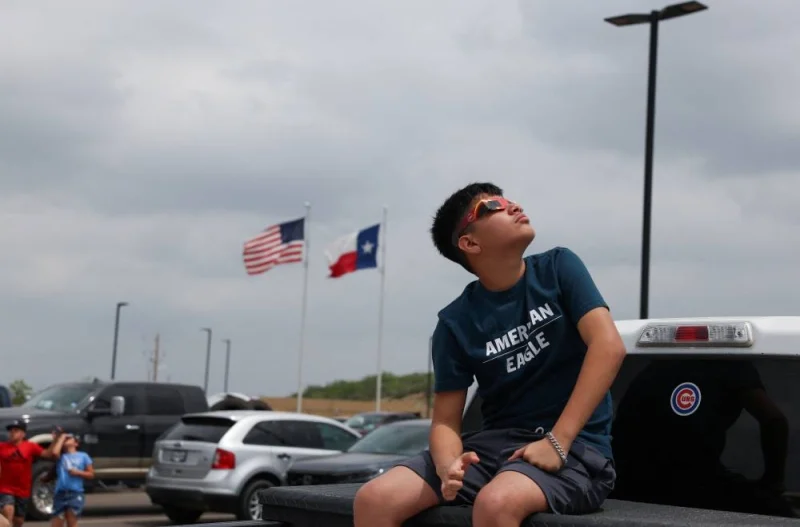
A boy looks up as people gather to view a total solar eclipse in Eagle Pass, Texas.
